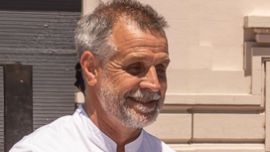Seven is traditionally a lucky number in the Western world but the 7.7 percent unemployment figure posted last Monday for the first quarter of this year is unfortunate for a host of people closer to two million than one. Yet however callous such analysis might sound, any single-digit percentage looks like a tolerable price to pay when measured against the myriad double-digit slumps highlighting the severity of the ongoing recession stemming from fiscal surplus austerity – a construction sector denied public works plunging 19.7 percent, manufacturing industry down 13.7 percent, a financial sphere enduring negative interest rates minus 13 percent, etc. etc. – all percentages beggared by a majority of the population being already below the poverty line according to some estimates. Such is the here and now but projecting the artificial intelligence obsessively on all lips nowadays, 7.7 percent of current jobs remaining safe might be considered good luck in a very near future.
This year’s slump is frequently compared to the 2001-2002 meltdown and yet there is far less unemployment now (21.5 percent back then). But the universal correlation between depression and unemployment breaks down in Argentina thanks to low productivity multiplying jobs. The historic pattern has been more jobs than people with widespread moonlighting and double-digit unemployment never arrived in Argentina until 1994, when it persisted through until 2006, never to return since then save in the pandemic year of 2020. Yet despite including that 2001-2002 meltdown, only three of those dozen years between 1994 and 2006 saw negative growth with the convertibility and commodity booms characterising the rest. Double-digit unemployment in the final decade of the last century was the other side of the coin to strong productivity gains from an economic modernisation drive – conversely the return to single-digit unemployment since 2006 largely stemmed from virtually doubling the public sector under the three Kirchner presidencies between 2003 and 2015.
Yet keeping over 90 percent of the workforce employed during over a decade of economic stagnation has come at a price for the workers themselves as well as for the economy – both a deteriorating quality of jobs with less social benefits and lower pay (real wages down 18-20 percent so far this year). How can having a job continue to be synonymous with making a living if there are around seven times as many people below the poverty line as jobless?
The Javier Milei administration raises hopes of reversing this decline in the quality of employment by pushing two key initiatives – labour law reform and bringing investment into the country via a stridently pro-market approach in general and the incentives contained in its ‘Ley de Bases’ omnibus bill in particular. Yet there are reasons to fear that neither move leads automatically to quality job creation.
The most dynamic sectors likeliest to attract investment, like the extractive industries and agriculture, are considerably less labour-intensive than the languishing construction or manufacturing – investments into improving efficiency and productivity would presumably do more to expel labour than expand it. The current rigid labour legislation is widely seen as favouring a shrinking unionised quarter of the workforce at the expense of the other three-quarters, blocking any formal employment offers to the latter due to employer fears of severance and even more the costs of litigation. Yet more flexible laws stand to erode the privileged rather than add to their ranks. Here the experience of Peru (which has started to replace Chile as the poster boy for Latin American pro-market reforms since the 2019 upheavals across the Andes) is illustrative – there almost three-quarters of the workforce are informally employed as against just under a half here. If Peronism constantly boosted its organised labour “spine,” why should Milei not do the same with his electoral base of food delivery cyclists, remote workers, the self-employed of all kinds, etc. consolidating informal employment? If low productivity was the key to low unemployment in the past, more precarious conditions could be the key to more jobs in the future.
While Milei sees investment and labour reform as the keys to decent jobs, other voices tend to underline education as the road with an urgent need to reverse the decline of recent decades. Yet here artificial intelligence raises its seemingly irreversible head to counter this paradigm – for the first time there could be less demand for skilled labour than unskilled with computer programming abruptly ceasing to be the work of the future. Only in recent years has the traditional university proclivity for professional careers (law, medicine, architecture, etc.) been challenged in the name of linking higher education more to the business and industrial worlds via applied science and technology – now this perception stands to be overtaken by artificial intelligence. Far from education and employment being welded into a new tandem, both will need to redefine their nature and purpose.
All that still lies in a future which could be closer than we imagine but the immediate past has already seen a major transformation via the pandemic, which overturned the traditional workplace and working hours by showing that people could work productively from home instead of commuting to offices enshrining Parkinson’s law (work expands to fill the time available for its completion, often with deadlines leading to their opposite of procrastination).
Impossible to see into the future. In conclusion, we can only say that even if the 7.7 percent unemployment figure is accurate (since it has been challenged as not including those in artificial job creation schemes or who have given up looking for work among other categories), we cannot draw any consolation from the notion that it could be a lot worse amid such a severe recession because, quite apart from the fact that youth unemployment triples the general average, this percentage is only the tip of an iceberg of poverty and exclusion.



















Comments